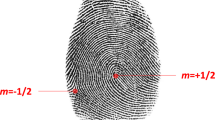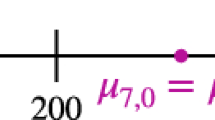Abstract.
We have used linear stability analysis to study the depinning of an elastic chain with long range interactions submitted to a random pinning potential. In this paper, we provide, for the first time, evidence of a pronounced change from a strong pinning regime to a weak pinning regime. This change depends on the strength of disorder, and takes place only in finite size systems. For a given disorder, we show a characteristic length separating the weak pinning regime from the strong pinning regime. This length depends on the long range of the algebraic decay of the elastic couplings. The weak pinning regime is very well described by perturbation theory. As an example, we discuss more specifically the case of wetting of heterogeneous surfaces, where the change from a strong to a weak pinning regime could be induced in the wetting front by varying the surface tension of the liquid-air interface.
Similar content being viewed by others
References
J. Schmittbuhl, S. Roux, J.-P. Vilotte, K.J. Maloy, Phys. Rev. Lett. 74, 1787 (1995)
E. Bouchaud, J. Phys.: Condens. Matter 9, 4319 (1997) For a large review, see Physical Aspects of Fracture, edited by E. Bouchaud et al. (NATO science study, September 2001)
J.F. Joanny, P.G. de Gennes, J. Chem. Phys. 81, 552, (1984)
P.G. de Gennes, Rev. Mod. Phys. 57, 827 (1985)
Y. Pomeau, J. Vannimenus, J. Colloid Interface Sci. 104, 477 (1985)
J. Crassous, E. Charlaix, Europhys. Lett. 28, 415 (1994)
J.-M. di Meglio, Europhys. Lett. 17, 607 (1992)
S. Ramos, E. Charlaix, A. Benyagoub, M. Toulemonde, Phys. Rev. E 67, 031604 (2003)
E. Rolley, C. Guthmann, R. Gombrowivz, V. Repain, Phys. Rev. Lett. 80, 2865 (1998)
A. Prevost, E. Rolley, C. Guthmann, Phys. Rev. B 65, 064517 (2002)
S. Moulinet, C. Guthmann, E. Rolley, Eur. Phys. J. E 8, 437 (2002)
T. Cubaud, Thèse de l’université Paris XI (2001); T. Cubaud, M. Fermigier, Europhys. Lett. 55, 239 (2001)
J.F. Joanny, M.O. Robbins, J. Chem. Phys. 92, 3206 (1990); M.O. Robbins, J.F. Joanny, Europhys. Lett. 3, 729 (1987)
R. Golestanian, E. Raphael, Phys. Rev. E 67, 031603 (2003)
A. Rosso, W. Krauth, Phys. Rev. Lett. 87, 187002 (2001); A. Rosso, W. Krauth Phys. Rev. E 65, 025101(R) (2002); A. Rosso, A.K. Hartmann, W. Krauth, Phys. Rev. E 67, 021602 (2003); A. Rosso, W. Krauth, P. Le Doussal, J. Vannimenus, K.J. Wiese, cond-mat/0301464
P. Le Doussal, K.J. Wiese, P. Chauve, Phys. Rev. B 66, 174201 (2002); P. Le Doussal, K.J. Wiese, Phys. Rev. E 67, 016121 (2003); P. Le Doussal, K.J. Wiese, cond-mat/0301465. P. Le Doussal, K.J. Wiese, P. Chauve, cond-mat/0304614
T. Nattermann et al. , J. Phys. II France 2, 1483 (1992)
D.S. Fisher, Phys. Rev. B 31, 1396 (1985)
D. Ertas, M. Kardar, Phys. Rev. B 53, 3520 (1996)
A. Hazareesing, M. Mézard, Phys. Rev. E 60, 1269 (1999)
S. Zapperi, P. Ciseau, G. Durin, E. Stanley, Phys. Rev. B 58, 6353 (1998)
A.I. Larkin, Y.N. Ovchinnikov, J. Low Temp. Phys. 34, 409, (1979); For a review, see T. Giamarchi, P. Le Doussal, in Spin Glasses and Random fields, edited by A.P. Young, (World Sci., Singapore,1997)
C. Caroli, P. Noziéres, in The physics of sliding friction, edited by B.N.J. Persson, Vol. 311 of NATO Advanced Study (Kluwer, Dordrecht, 1996)
C. Caroli, P. Noziéres, Eur. Phys. J. B 4, 233 (1998)
B.N.J. Persson, Sliding Friction (Physical Principles and Applications) (Springer-Verlag, Heidelberg, 1998)
R. Burridge, L. Knopoff, Bull. Seismol. Soc. Am. 57, 341 (1967)
L. Bocquet, H.J. Jensen, J. Phys. I France 7, 1603 (1997)
A. Tanguy, Thèse de l’université Paris VII (1998)
S. Krishnamurthy, A. Tanguy, P. Abry, S. Roux, Europhys. Lett. 51, 1 (2000)
S. Krishnamurthy, A. Tanguy, S. Roux, Eur. Phys. J. B 15, 149 (2000)
A. Tanguy, M. Gounelle, S. Roux, Phys. Rev. E 58, 1577 (1998)
L.-H. Tang et al. , Phys. Rev. Lett. 74, 920 (1995); M. Kardar, Phys. Rep. 301, 85 (1998); P. Le Doussal, K.J. Wiese, Phys. Rev. E 67, 016121 (2003)
A. Paterson et al. , Phys. Rev. E 51, 1291 (1995) A. Paterson, M. Fermigier, Phys. Fluids 9, 2210 (1997)
Let us recall that, in the context of this paper, temperature is zero. Thus an equilibrium position is simply one of the configurations of the contact line, where the sum of forces acting on the line, is equal to zero
http://www.netlib.org/eispack
http://www.caam.rice.edu/software/ARPACK/
We have checked that this kind of distribution corresponds precisely to the distribution of pinning forces along the chain when it reaches its first equilibrium position: using conjugated gradient method, we have quenched very quickly a chain initially flat on a random surface. When the disorder on the surface, here the amplitude of the pinning centers, is decorrelated, the disorder along the chain at equilibrium is also decorrelated. The morphology of the line is not the same in the s trong or in the weak pinning regime. The roughness exponent of the chain at equilibrium in the weak pinning regime is \(\zeta =(2\alpha -3)/2\) as found already by Larkin et al. [22, 25]. A. Tanguy and T. Vettorel, in preparation (2003)
J.M. Ziman Models of disorder (Cambridge university press, Cambridge, 1979)
J.-M. Luck, Systèmes désordonnés unidimensionnels (Aléa Saclay, Gif-sur-Yvette, 1992)
C. Cohen-Tannoudji, B. Diu, F. Laloë Mécanique Quantique, tome II (Hermann, Paris, 1973)
E.M. Chudnovsky, R. Dickman, cond-mat/9710184
Author information
Authors and Affiliations
Corresponding author
Additional information
Received: 12 September 2003, Published online: 20 April 2004
PACS:
05.10.-a Computational methods in statistical physics and nonlinear dynamics - 68.08.Bc Wetting - 02.50.Fz Stochastic analysis
Rights and permissions
About this article
Cite this article
Tanguy, A., Vettorel, T. From weak to strong pinning I: A finite size study. Eur. Phys. J. B 38, 71–82 (2004). https://doi.org/10.1140/epjb/e2004-00101-6
Issue Date:
DOI: https://doi.org/10.1140/epjb/e2004-00101-6




